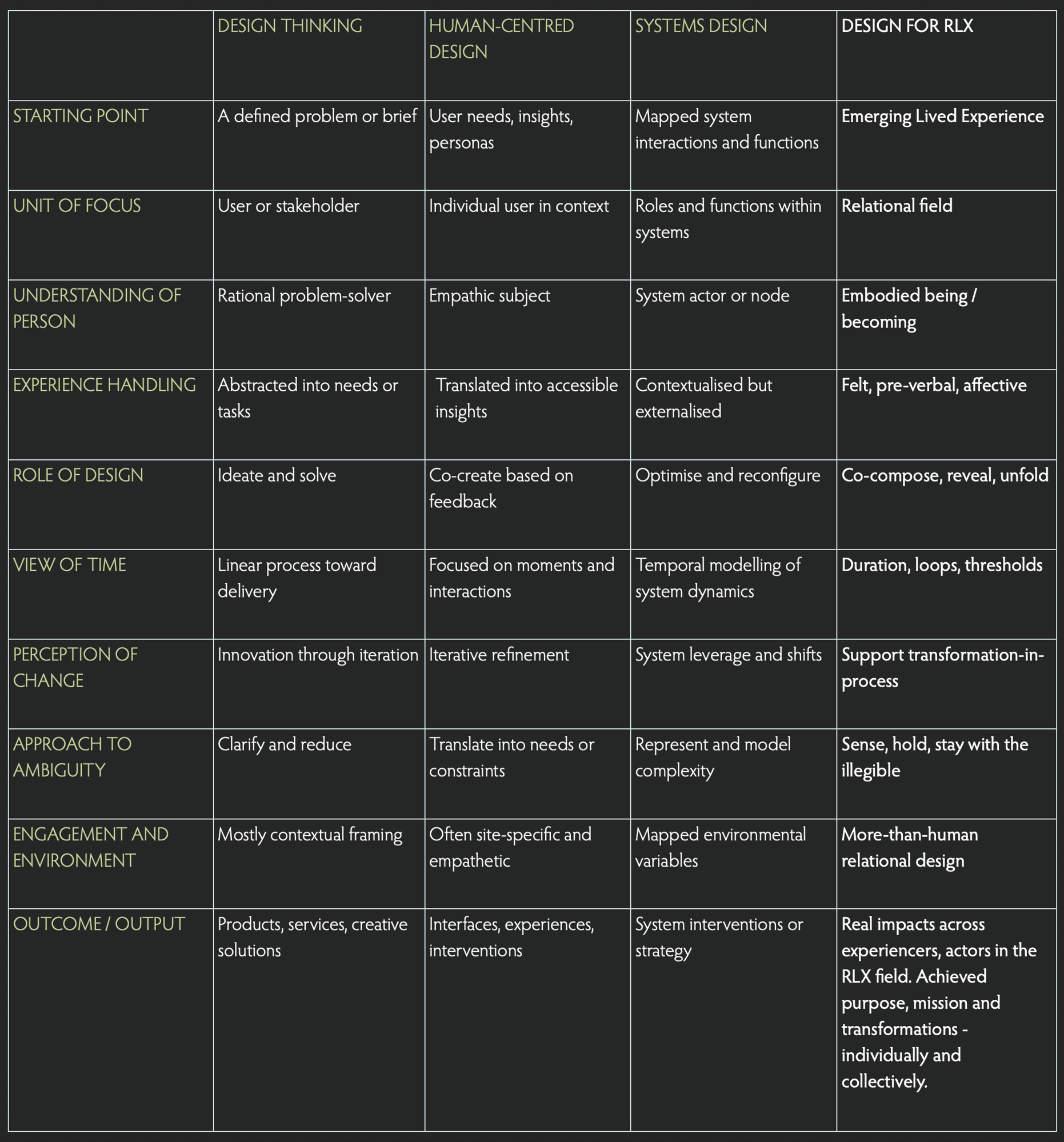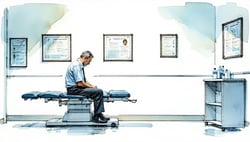Why Design with Real Lived Experience (RLX)?

Design with RLX starts from the lived reality of health - not from abstractions, metrics, or predefined categories.

It moves with experience as it emerges - and can get stuck - across wider relational fields of people, places, resources, ideas, and systems.

And in times of chronic illness, transition, constraint, or deep uncertainty, Design with RLX creates real meaning, value, and change that lasts.
Deeper Insight
Uncovers the real structure and affective dynamics of experience - revealing what's shaping it beneath surface narratives or reported needs.
Greater Relevance
Generates responses that are attuned to how people actually live, not just what they say or how they behave - especially in complex or marginalised contexts.
Relational Fit
Designs with the full ecology of experience - including social, spatial, bodily, technological, and emotional dimensions - making solutions feel naturally integrated, not imposed.
Expressive Power
Surfaces the unspoken, ambiguous, or pre-verbal aspects of lived experience - allowing people to see, share, and shift experience in ways that feel true.
Transformational Impact
Doesn’t just improve existing systems - it supports new ways of being, relating, and becoming within experience. It enables meaningful transformation, not just incremental change.
Capacity Creation
Instead of dependency or compliance, RLX design creates conditions for new capabilities to emerge - both for individuals and the systems around them.
Durability
By working with real conditions of experience (not abstracted needs), RLX-based designs are more likely to sustain change over time - because they move with life’s rhythms, not against them.
Ethical Grounding
Supports co-creation without extraction. Designs are not applied to people, but composed with them, in rhythm with their becoming.
Market Growth and Differentiation
Design with RLX allows companies to differentiate their offerings in saturated markets by delivering experiences that feel truly understood and deeply resonant. In a competitive healthtech or medtech landscape, relational fit and emotional trust become market advantages
Improved Product–Market Fit
By designing from within real lived experience, RLX helps avoid the trap of building features no one truly needs or uses. It de-risks development by ensuring solutions align with how life is actually lived, not just what surveys or system analytics report.
Innovation from the Margins
RLX enables enterprises to see value where others see noise - in the lives of those who are often underserved, unheard, or difficult to standardise. This becomes a source of true innovation and blue-ocean opportunity.
Cost-Saving through Systemic Insight
Misaligned interventions often lead to rework, disengagement, and downstream burden. RLX reveals the upstream conditions and assemblages that shape outcomes - allowing you to design once, well, and relationally.
Cultural and Workforce Retention Value
For healthcare providers and systems, RLX fosters relational awareness and emotional grounding - not only for patients but for clinicians, carers, and staff. It addresses burnout, disconnection, and moral injury not with wellness initiatives, but through shared transformation of the experience field itself.
- Distinct positioning in emerging health and care markets
- Increased patient, clinician and provider loyalty through perceived empathy and precision
- Growth in under-served segments through attuned innovation
- Authentic alignment with ESG, equity, and human-centred care values
- Lower cost of failed pilots or low-adoption rollouts
- More efficient, relationally validated R&D
- Improved uptake and engagement across touchpoints (apps, devices, services)
- New offerings born from chronic illness, disability, menopause, mental health, etc.
- First-mover advantage in emerging spaces of care innovation
- Cultural capital and leadership as a relational design pioneer
- Lower burden on care providers and systems
- Reduction in unnecessary service use (e.g. repeated GP visits due to misrecognised symptoms)
- Improved resource allocation across teams or populations
- Cost-effective innovation
- Stronger trust between staff and system
- Retention of mission-driven professionals
- More resilient and relationally intelligent care environments


Chronic pain isn’t just a health condition. It’s a lived reality that touches every part of a person’s being - body, memory, identity, space, time, and relation. And yet, most systems and tools designed “for pain” reduce it to data, symptoms, or tracked inputs. They miss the texture. The complexity. The felt reality of living through pain - every day.
Here is how Design with RLX differs and helps.
Surfaces the invisible
Design with RLX reveals what isn’t usually captured in clinical forms or digital tools:
- The ebb and flow of pain across time and space
- How pain interacts with memory, mood, energy, and environment
- The social and spatial isolation that pain creates
- The tensions between coping, masking, and expressing
Real Impact
People feel seen - not just as patients, but as lived realities in motion.
Supports expression without translation
People in pain often struggle to articulate their experience in words others can understand.
Design with RLX enables non-verbal, spatial, temporal, and visual forms of expression.
Real Impact
They no longer need to “explain” their pain. They can express it - and have it recognised.
Reveals patterns and conditions
Using Umio services and tools like Bergson or Ooex, Design with RLX helps map:
- What triggers pain
- What soothes it
- What kinds of interactions or rhythms amplify or ease it
Real Impact
People begin to perceive the conditions shaping their pain, giving them agency to shift them - gently, and with support.
Enables real-time insight and care
Rather than asking people to recall or track pain as data, Design with RLX supports sensing and responding to what’s happening now.
Real Impact
People gain tools to respond in the moment - through movement, environment, relation, or rest - rather than pushing through or collapsing into suffering.
Creates space for co-regulation and relational support
Pain isolates. But RLX design enables shared perception of experience - among carers, clinicians, peers, or loved ones.
Real Impact
Others can feel with the person in pain - without needing to “fix” them.
This reduces isolation and restores a sense of shared meaning.
Builds new capacities
Design with RLX doesn’t just help people “manage” pain. It helps them:
- Re-orient their attention
- Tune into micro-movements of ease
- Create rituals or environments that support re-becoming
- Discover new ways of living with their body
Real Impact
People feel less trapped by pain - and more able to move, express, and engage on their own terms.
In short, Design with RLX doesn't offer a cure for pain. It offers a shift. It helps people living with chronic pain:
- Be more deeply perceived and understood
- Understand and express their experience
- Rebuild trust in their own sensing
- Shift how they relate to pain, place, time, and others
- Co-compose new rhythms of care, creativity, and connection
This isn’t about managing pain better. It’s about designing with the reality of pain so that people can reclaim life from within it. And that - in the context of pain - is a real impact. Not just in design terms, but in life terms.

Menopause is more than a hormonal shift. It is a relational, embodied, and transitional experience - one that reshapes identity, rhythms, memory, intimacy, and time. Yet most design responses to menopause focus on hormone levels, symptoms, standardised interventions and lifestyle advice or clinical “management”. What’s missing is a way to truly perceive what menopause feels like - and what it does to the texture of someone’s life.
Here is how Design with RLX differs and helps.
Recognition Beyond Symptoms
Most women navigating menopause feel unseen - either over-medicalised or completely ignored.
Design with RLX enables them to express their experience in ways that aren’t flattened into checklists or stigma.
Real Impact
Women feel recognised and reflected in all their nuance, contradiction, and power - not reduced to “hot flashes” or “hormonal imbalance.”
Space to Express What’s Hard to Articulate
Menopause often brings emotional, relational, and existential shifts that are hard to explain - grief, rage, freedom, disorientation.
Design with RLX makes room for expression without requiring translation into clinical or social language.
Real Impact
Women can express what they’re actually living through - on their own terms, in ways that feel safe, true, and creative.
Mapping Invisible Transitions
Using tools like Bergson or Ooex, Design with RLX surfaces how menopause intersects with place, work, intimacy, memory, and identity - revealing changes that aren’t tracked by apps or spoken in clinics.
Real Impact
Women begin to see patterns in their own experience - what’s shifting, what’s grounding, what needs to change.
New Language and Meaning
Menopause is often framed as decline, dysfunction, or invisibility.
Design with RLX enables women to re-narrate the experience as a process of becoming - even if uncomfortable or disorienting.
Real Impact
Women find language, metaphor, and design forms that give meaning to their transitions - reframing menopause as generative, not just disruptive.
Support Without Fixing
Instead of trying to “treat” menopause, Design with RLX co-composes conditions for ease, restoration, creativity, or connection - based on the woman’s own relational ecosystem.
Real Impact
Women feel supported rather than solved - able to shape their rhythms and responses with more agency and clarity.
Capacity Creation
Design with RLX doesn’t just accommodate change.
It helps grow new ways of sensing, relating, and moving through the world - even in uncertainty.
Real Impact
Women gain new capacities - to feel differently about their bodies, to ask for what they need, to design new forms of care or community.
Community and Relational Perception
Through shared RLX tools or platforms, women can connect with others experiencing similar transitions - not through comparison, but resonance.
Real Impact
Menopause becomes less isolating - more of a shared becoming, with language and care that can evolve in community.
In short, Design with RLX doesn't see menopause as a condition to be managed. It's a life passage to be recognised - and co-designed with. It helps people experiencing menopause to:
- Feel recognised
- Express the inexpressible
- Make sense of change
- Design new rhythms of life
- Reclaim meaning, beauty, and agency
- Transform not just how they live, but how they are seen
Design with RLX helps make the menopause visible. It supports care, creativity, and transformation from within the experience itself. And that - in the context of menopause - is a real impact..